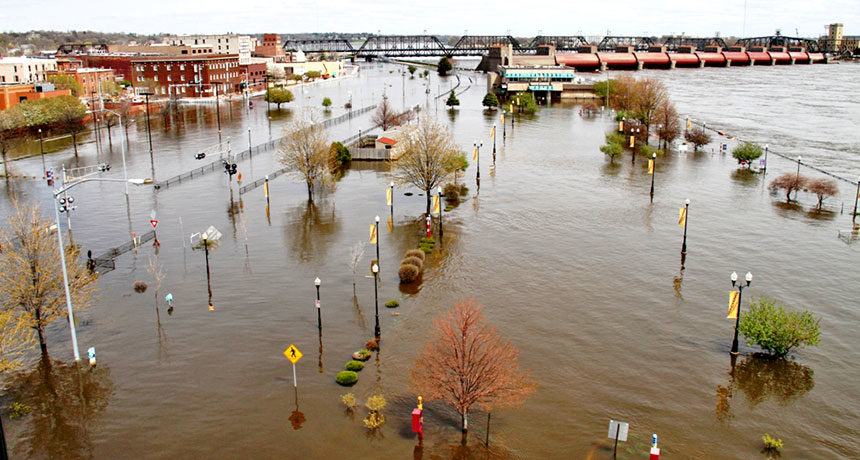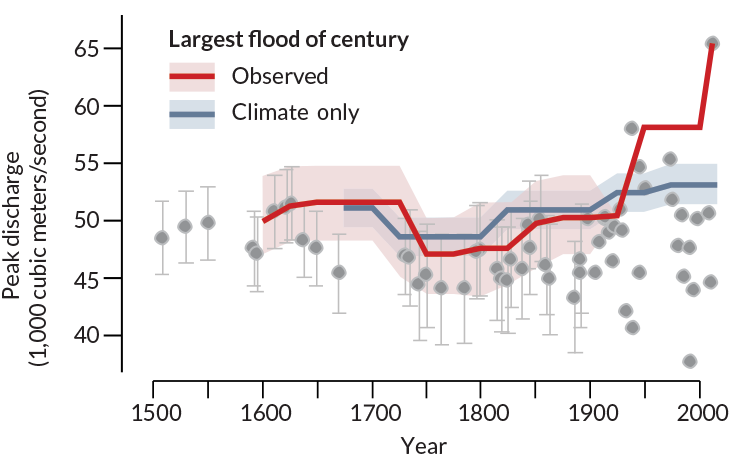
Using tree rings and lake sediments, researchers re-created a history of flooding along the lower Mississippi River extending back to the 1500s. This paleoflood record suggests that the past century of river engineering - intended to minimize flood damage to people living along the river's banks - has instead increased the magnitude of the largest floods by 20 percent, the researchers report April 5 in Nature.
Climate patterns that bring extra rainfall to the region don't account for the dramatic increase in flood size, the team found. "The obvious culprit is that we have really modified the river itself," says Samuel Munoz, a geoscientist at Northeastern University in Boston.
Settlers built the first levees on the Mississippi in the early 1800s. After a massive flood displaced hundreds of thousands of people in 1927, the U.S. government built the current system of spillways and levees. The engineering projects profoundly altered the river's shape and sediment content. But how these changes affected the size of the river's largest floods has been unclear, in part because water gauges have tracked the river's flow for just 150 years.
"One of the difficult things about studying extreme floods is that you don't get many," says paleohydrologist Scott St. George of the University of Minnesota in Minneapolis, who wrote an accompanying commentary in Nature. "Floods like the one in 1927 don't come around very often."

"You get deposits of river material in which the coarse stuff settles out fastest and the finer stuff is on top," Munoz says. As evidence of past floods, the team looked for this sediment pattern in cores from three oxbow lakes. Comparing recent flood sediment sequences with those floods' actual size, the researchers created a template for assessing the magnitude of older floods.
Identifying "flood rings" in tree-ring samples from 35 oak trees along the lower river's floodplain helped researchers pin down the timing of the floods. When a tree is inundated, tree ring vessels - cells that transport water and nutrients - may shrink or be distributed differently within that ring, compared with in rings not affected by floods.
The researchers next considered the influence of two large weather patterns known to bring wetter conditions to the central United States - the El Niño-Southern Oscillation and the Atlantic Multidecadal Oscillation. The team analyzed historical data for these patterns back to the late 19th century, and reconstructed the patterns back to 1500. Those weather patterns are linked to warmer surface temperatures in the Pacific and Atlantic oceans, respectively, and correlated with the timing of observed floods on the lower Mississippi. But they weren't the whole story.
Largest floods
A century flood is a flood so large it only occurs about once every 100 years. Over the last 500 years, the highest water flow during a century flood has increased by 20 percent (red line). Dots represent floods tracked by tree rings and oxbow lakes, as well as instrumental data recorded after about 1900. The blue line represents how the trend would look under "climate-only" conditions, without human engineering of the river.
"The early 20th century got a lot of flooding," but only 25 percent of the increase in flood magnitude over the past century can be explained by those climate patterns, Munoz says. The other 75 percent was probably due to the river modifications, the researchers found.
River modification is a plausible explanation for the increase in Mississippi flood extremes, St. George says. But there are other possible climate impacts, he notes, such as the fact that the area is warmer now than 150 years ago. These could also have affected rainfall and river flow in the Mississippi River basin.
Still, he says, the 500-year flood record is an important part of solving that puzzle. "It gives a long-term perspective on the Mississippi, which you really need to understand a river of its size and majesty."
Munoz says this method of establishing a flood record that predates river gauges can be applied to other rivers, whether heavily managed or not. It could also help scientists understand how flood risks might change with increasing greenhouse gases in the atmosphere (SN: 9/2/19, p. 14). "This approach can help take the pulse of a river and determine how unprecedented such changes might be."




Comment: As evidenced by the waterways around the industrialised world that tend to be filthy and increasingly devoid of life, there is a lot we do not yet know about water. At the same time, as noted in the article, flooding was still on the increase which is probably attributable to our planets entry into an ice age:
- Massive flooding in Europe during the Little Ice Age
- What is the fourth phase of water?
- Washington's Skagit River causes major flooding from highest flow in 11 years
Also check out SOTT radio's: The Health & Wellness Show: Water: What Do We Really Know?